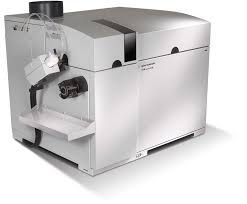Equipment Index
Mass Spectrometry
Inductively Coupled Plasma Mass Spectrometer (ICP-MS)
- 8900
- 7700-X
Liquid Chromatography Tandem Mass Spectrometry (LC-MS/MS)
LC-MS/MS (triple quadrupole; unit resolution)
LC-MS/MS (Q-ToF; high resolution)
LC-MS/MS (Q Exactive Orbitrap; high resolution)
Gas Chromatography Tandem Mass Spectrometer (GC-MS/MS)
Other Analyses
UV-Vis/Fluorescence Spectrophotometer- Horiba Aqualog
Size Exclusion Chromatography/Asymmetric Field Flow Fractionation-Multi-angle Light Scattering (SEC/AFFF-MALS)
X-ray Fluorescence (XRF) Spectrometry- Spectro XEPOS
CNS Analyzer- Costech ECS
Ion Chromatography- Dionex ICS-6000
Carbon/Nitrogen Analyzer- Shimadzu TOC-L (Total Organic Carbon) + TNM-L (Total Nitrogen)
Sample Preparation
Solid Phase Extraction Workstation- AutoTrace SPE 280
Microwave Digestion- CEM-MARS 6
__________________________________________________________
Instrument Descriptions
Inductively Coupled Plasma Mass Spectrometer (ICP-MS)


The Elan DRC-II ICP-MS system handles solutions from a variety of sample types. Environmental samples such as drinking water, wastewater, extraction solutions and digests from soils, sediments, plant materials and biosolids are the most common sample types that we analyze. These matrices can present an analytical challenge due to spectral interferences caused by other elements present in the sample. An example is the presence of chloride atoms which form a polyatomic species with argon (40Ar35Cl), resulting in a signal at the same mass-to-charge (m/z) as arsenic (75As), giving a false positive response. We can reduce the occurrence of such false signals with this instrument by using a Dynamic Reaction Cell (DRC), a small, enclosed cell located in the ion stream in front of the quadrupole which can be purged with an alternate gas, breaking up the Ar complexes before they can enter the mass filter and detector regions. This allows improved detection limits in these complex matrices.
A recent improvement to the sample introduction system was the installation of a Perkin Elmer Series 200 High Performance Liquid Chromatography (HPLC) system. This provides the capacity to perform chromatographic separations prior to analysis by ICP-MS (often referred to as LC-ICPMS). Such hyphenated techniques are used to separate and quantify the more toxic forms of an element (such as arsenite, As(III) from those less hazardous species (arsenobetaine (AsB) commonly found in urine after consumption of certain seafoods, and considered non-toxic).
Liquid Chromatography Tandem Mass Spectrometry (triple quadrupole; unit resolution)

